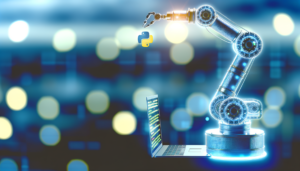Python Automation with AI: Revolutionizing Efficiency

In today’s fast-paced digital world, businesses and developers are constantly seeking ways to streamline processes and improve efficiency. Python, a versatile and powerful programming language, has emerged as a key player in automation. When combined with Artificial Intelligence (AI), Python automation becomes even more transformative, enabling smarter, faster, and more adaptive solutions. This article explores how Python automation, enhanced by AI, is revolutionizing industries by automating repetitive tasks, optimizing workflows, and enabling intelligent decision-making. From data processing to predictive analytics, the synergy between Python and AI is unlocking new possibilities for innovation and productivity.
The Power of Python in Automation
Python’s simplicity and readability make it an ideal choice for automation. Its extensive libraries, such as Pandas, NumPy, and Selenium, allow developers to automate a wide range of tasks, from web scraping to data manipulation. Python’s cross-platform compatibility ensures that automation scripts can run seamlessly across different operating systems. Moreover, its integration capabilities with APIs and databases make it a go-to tool for automating complex workflows. Whether it’s automating email campaigns, generating reports, or managing cloud infrastructure, Python provides the flexibility and scalability needed to handle diverse automation challenges.
AI Integration: Taking Automation to the Next Level
While Python alone is powerful, integrating AI elevates automation to new heights. AI technologies, such as machine learning (ML) and natural language processing (NLP), enable systems to learn from data, make predictions, and adapt to changing conditions. For instance, Python’s TensorFlow and PyTorch libraries allow developers to build AI models that can automate decision-making processes. AI-powered chatbots, predictive maintenance systems, and intelligent data analysis tools are just a few examples of how Python and AI are transforming industries. By leveraging AI, businesses can automate not just repetitive tasks but also complex, cognitive tasks that require human-like reasoning.
Real-World Applications of Python Automation with AI
The combination of Python and AI is already making waves across various sectors. In healthcare, AI-powered Python scripts are being used to analyze medical data and predict patient outcomes. In finance, automated trading systems built with Python and AI algorithms are optimizing investment strategies. Retailers are using AI-driven recommendation engines to personalize customer experiences, while manufacturers are deploying predictive maintenance systems to reduce downtime. These real-world applications demonstrate the transformative potential of Python automation with AI, offering businesses a competitive edge by improving efficiency, reducing costs, and enhancing decision-making.
Challenges and Future Trends
Despite its many advantages, Python automation with AI is not without challenges. Data privacy concerns, the need for high-quality datasets, and the complexity of AI models can pose significant hurdles. Additionally, the rapid pace of technological advancements requires continuous learning and adaptation. However, the future looks promising. As AI becomes more accessible and Python continues to evolve, we can expect even more sophisticated automation solutions. Emerging trends, such as edge computing and federated learning, are likely to further enhance the capabilities of Python automation with AI, paving the way for smarter, more autonomous systems.
Conclusion
Python automation with AI represents a powerful synergy that is reshaping industries and driving innovation. By automating repetitive tasks and enabling intelligent decision-making, this combination is unlocking new levels of efficiency and productivity. From healthcare to finance, real-world applications are already demonstrating its transformative potential. While challenges remain, the future of Python automation with AI is bright, with emerging trends poised to further enhance its capabilities. For businesses and developers alike, embracing this technology is not just an option—it’s a necessity to stay competitive in an increasingly automated world. The journey of Python automation with AI is just beginning, and its possibilities are limitless.